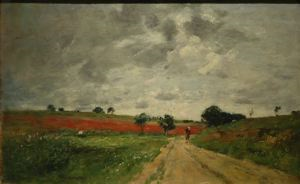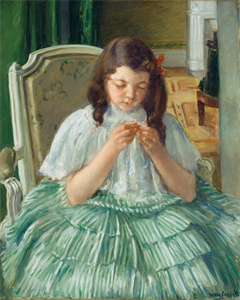
Eugène Boudin (aka Louis Eugene Boudin)
French, (active 1824–1898)
The solitary figure in "Road in Countryside" emerges from a bend in a rural road that lacks recognizable landmarks. The artist, Eugene Louis Boudin, provides no clues as to the figure’s destination, nor the purpose of his travel. By showing neither the beginning nor the end of the road, Boudin creates a sense of infinity and timelessness. Perhaps, the artist is suggesting the never-ending labors of the country’s peasants, or the slow evolution of the way of life for rural residents. For the nineteenth-century viewer, the stark, barren landscape would have been seen in juxtaposition to the emergence of urban life, and the rise of manufacturing and commerce, versus the agrarian way of life that dominated for centuries. In contrast to this sense of a world out of time, the sky suggests the opposite—the impending storm emphasizes the inevitability of change wrought by the passage of time. The painter was a proto-Impressionist—he influenced the work of Claude Monet (French, 1840-1926) by emphasizing the importance of painting outdoors and on-site to capture the fleeting effects of light and color in nature.
French, (active 1824–1898)
Road in Countryside
Object Type:
Painting
Creation Place:
Northern Europe, French
Dimensions:
14 in. x 22 3/8 in. (35.56 cm x 56.83 cm)
Medium and Support:
Oil on canvas
Accession Number:
1977.0544
Credit Line:
Bequest of William Pelzer Arrington in memory of his mother, Ethel Pelzer Arrington
The solitary figure in "Road in Countryside" emerges from a bend in a rural road that lacks recognizable landmarks. The artist, Eugene Louis Boudin, provides no clues as to the figure’s destination, nor the purpose of his travel. By showing neither the beginning nor the end of the road, Boudin creates a sense of infinity and timelessness. Perhaps, the artist is suggesting the never-ending labors of the country’s peasants, or the slow evolution of the way of life for rural residents. For the nineteenth-century viewer, the stark, barren landscape would have been seen in juxtaposition to the emergence of urban life, and the rise of manufacturing and commerce, versus the agrarian way of life that dominated for centuries. In contrast to this sense of a world out of time, the sky suggests the opposite—the impending storm emphasizes the inevitability of change wrought by the passage of time. The painter was a proto-Impressionist—he influenced the work of Claude Monet (French, 1840-1926) by emphasizing the importance of painting outdoors and on-site to capture the fleeting effects of light and color in nature.
Keywords
Click a term to view the records with the same keyword
Portfolio List
Click a portfolio name to view all the objects in that portfolio
This object is a member of the following portfolios:
Your current search criteria is: Keyword is "NU".

 by Artist (17)
by Artist (17)
